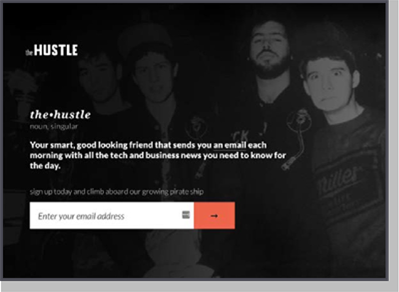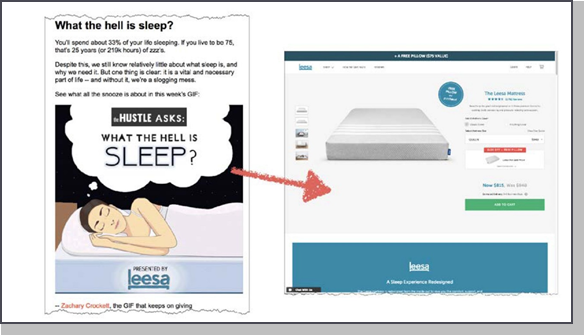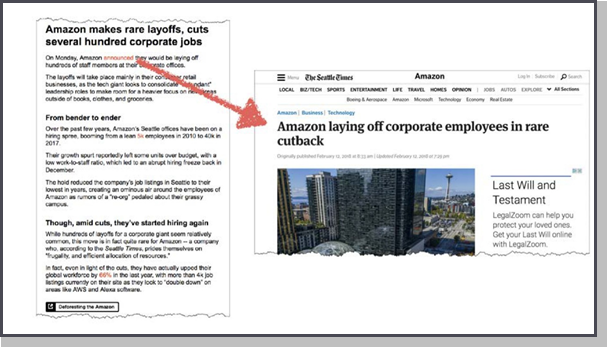Sam Parr
Sam Parr is the founder of The Hustle, one of America’s fastest growing media companies. Each month over 10 million young people refer to The Hustle to get the business news they need to start their day. Sam is also the founder of Hustle Con—a one-day startup conference where the best, non-technical startup founders tell the stories, tactics, and tips they used to start and grow their startup.
Who is your smart good-looking friend that sends you an email each morning with all the tech and business news you need to know for the day?
You don’t need to go to SoHo house to find them. Just sign up for The Hustle email list. The Hustle is a business newsletter sent out every morning to 700,000 young professionals. It is funny, informative, and intelligent news that has taken the idea of a BuzzFeed style website and curated it into a daily email.
The Hustle grew from zero subscribers to 500,000 in 18 months.
This is how.

The Hustle is a publication for ambitious people, with a large audience of millennials. Since day one, the copywriting has been designed for this specific niche of people. The idea was always to sound like buddies in a room having a conversation and talking about business topics. Conversations about Jeff Bezos and Uber were curated into copywriter subject lines and headers.
They call this the John Stewart effect. It’s a tone of voice that is incredibly intelligent but also self-detracting and funny. In using this voice, the founders of Hustle found that people trusted them more.
Two years in and The Hustle houses 20 employees and three full time writers.
The initial choice to create an email publication versus an article publication came from the massive decline in Facebook page reach. Email continues
to have the best numbers in terms of reach and doesn’t involve hiring more writers. Whether The Hustle reaches 700,000 viewers or five million viewers, they don’t need to create more content to ensure success.
How does an email publication make money?
95% of revenue comes from advertising within the email. Investments were initially made by very popular angel investors. The Hustle has a five person direct sales team with a CMS system and works with companies like Microsoft, Red Bull, and Walmart. They also work alongside smaller startups like Funrise and Robin Hood. These companies pay large amounts of money to advertise to very affluent and engaged audiences. For every dollar they spent, their ROI is much higher.

When the founders of The Hustle thought of email, they didn’t think about a certain amount of words to put in an email. They thought about how much data to fit into it.
GIFS are a great example of this. They place a lot of data into a small amount of space, using hacks to keep the GIFs small. When an image is in an email, it’s stored in another server. Whenever an email is refreshed, it’s a totally new image each time. The engagement rates on GIF’s are extremely high.
These engagement rates mean that big companies want to work with The Hustle. When The Hustle advertises with these companies, they have a systemized process. The engineers and co-founders have built the system. It starts with a company, like Microsoft, saying they want to reach a million people over five days and here are the people they want to reach. The sales team will then ask the company to fill out a form explaining the messaging they want to get across. This form is sent to the copywriters who create the copy that goes into the emails.
Once the writer clicks submit for that email, each story in the email is automatically built into the website and it turns into an article. Users in the email can click share and push the content to a larger audience. The articles can also rank on Google, be posted on social and drive more traffic growing subscriber numbers. The Hustle charges $20 to $40 per thousand sent. The CPM for YouTube is $4.
A major action The Hustle has implemented is in sending an indoctrination email. The subject line starts with, “Look what you did, you little jerk” and the email goes on to talk about all of the things that have happened since the person subscribed. New subscribers instantly get the vibe of The Hustle and can decide whether they hate it or love it.
This is where The Hustle started, with a strong inclination to have people either love them or hate them.
There are now 12-15 blog posts written about The Hustle welcome email. The pop ups, unsubscribe, thank you, and welcome emails are all very purposefully on brand.
The Hustle founders believe that having a strong brand transcends tactics. Building a brand that people love creates brand ambassadors, like the writers who curated articles on the welcome email, that are happy to promote for them.
Brand ambassadors has been one of the largest and fastest ways The Hustle has grown. They currently have 4,000 ambassadors that have each referred 22 people. The ambassador program gives a unique URL that can be shared with friends and in return for sharing, the user gets access to a handful of things. If they share with four friends, they get access to a private Facebook group with investors like Tim Ferriss or the Bleacher Report. These power players will go into the group to talk and be interviewed.
If you share with 25 people, you get a t-shirt. Ambassadors who share with 100 people get a hoodie.
The brand ambassador program has transformed The Hustle and helped grow it to reach the masses. Within each email are links to their content as well as others. For example, they’ll place a link to the Seattle Times if it means the reader will have a better experience by being able click on that and receive more information on the topic. This makes The Hustle more valuable to them and more likely to open future emails.

Before becoming a force of its own, The Hustle started as an entrepreneurial conference called Hustle Con. The newsletter was initially designed to promote the conference. When the first Hustle Con sold out, the founders saw the potential. Now that the membership website has grown, the future is in creating a movement.
Entrepreneurship is an underdressed market. The Hustle’s target audience is ambitious, smart, fun-loving person with a high bullshit detector. The theory is that the best way to circumvent one’s bullshit detector is to avoid bullshitting. In content, aligning an audience, getting their interest, and then gaining their trust will open the door for hundreds of other ways to monetize. With information on where their viewers work, their LinkedIn information, Twitter follower count, and more, The Hustle can create influence for more products.
The Hustle grew from zero subscribers to 500,000 in 18 months using basic strategies and a major attention to detail. Curating a brand from scratch, without a fear of backlash, has been one of their largest reasons for success.
Their sights are set on a bright future and an impactful movement that can resonate with a wider audience than they currently do.
